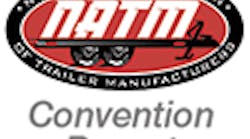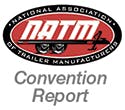Production-based pay systems can be rewarding, but also challenging if not planned thoroughly and implemented properly. It is not for all shops.
But those that succeed can experience an increase in productivity of 20% or more while the employee earns a rate subject to his ethic and efforts.
“At the end of the day, all of us want to increase productivity and make higher profits while producing a quality product,” said Pat Godwin Jr, president of The Godwin Group, “and this is one way to do so.”
Godwin said some people would have preferred he did not give his presentation—“Production Pay, Making Money on Both Sides of The Fence”—because they feared he’d give away lucrative trade secrets.
Godwin gave these key points to consider before initiating a production system:
• Do not attempt this without sufficient capital to see it through.
“This is the main one. Make sure you are financially prepared. Because if it is a success, you’re going to need to bankroll it and keep the ball rolling. So you need to be financially sound and financially prepared for about a 20% increase in production. That’s basically what happened to us when we went to a production-based system.”
• Have supervisors do time studies and set production rates, not the employee.
“You want to make it where it’s fair for the employee, but it also has to be fair for the company, too. It has to serve two purposes. It’s a lot easier in the beginning to set the scale a bit lower than what you think it could be. And if it proves to be just a little too low, you can put money in that guy’s pocket and change the direction. But if you paid for that guy to do what you thought was a $20 job and it ends up being more of a $10 job, you got it wrong because you can’t take money out of that guy’s pocket. So you have to be careful how you calculate it.
“In the past, we got the supervisor to set the rates. A supervisor has been around long enough and is experienced enough that he knows these jobs because he taught the guy that’s working there. It would be most appropriate for the supervisor to actually set the pay scale or the rate.
“One of the things we did recently was to allow the employee to have total control of the layout of his work area. He knows how he works most efficiently. After he goes home, we will reload his work cell for production the next day, and he tells us where he wants these parts to make it more efficient and productive for him. Most of our jobs are based on production—they are not paid by the hour. We have some people who are making good wages.
“There’s another way of looking at it. You can have an efficiency person who roams around the shop with a clipboard and camps out at someone’s work cell and sees what they’re doing efficiently and what they are not. Just keep up with this person as an observer. Find out where the efficiencies are at.”
• Be sure you have enough fabrication capabilities.
“Think about it. If I’m going to increase my production by 20%, that means my fab shop has to increase by 20%. The worst thing in the world you can do is to put a production-type system in and not have enough money in the bank to sustain it. If this takes off and is successful for you, make sure you’re going to be able to maintain that, because you will need more material, faster production, replace outdated machines, and put in machines. There are so many things you need to take into consideration.”
• Be sure drawings are updated to reflect the latest changes or shortcuts will happen, with you to blame.
“Make sure any modifications make it back to the engineering department or employees will shortcut this thing.”
• Develop an iron-clad quality assurance program.
“A lot of people say, ‘Well, in a production environment, the quality is going to go down.’ It doesn’t have to. This sounds a bit unusual but it works: This guy is making a very good wage for our region of the country and we’re paying him a fair wage to produce that widget the first time. If he chooses to not produce it correctly and doesn’t hold to quality standards like he should, then he gets the opportunity to come back and repair it on his own time. You don’t have to call someone out more than once or twice. They get the message. When we imposed that, we didn’t need as many QC people. We only needed one on the line of about six or eight welders to go by at the end of the day and check off on their work and sign off on it. You don’t have to have a supervisor standing over them and hovering over them. Let them know upfront that this is the way it’s going to be.”
• Set pay target for production work.
“I’m based out of North Carolina, but this happened at one of our other locations. We had a very good employee who had been there for a long time. When we got ready to implement a production system, he quit. Three weeks later, when his buddies started making money, he came back and applied for his job as a new employee. The guys want this to work. We’re going to make some mistakes. But we’re going to work together to work these things out. If any of you don’t want to go with the plan to make more money, well, there’s the door. The guy took that door, but three weeks later applied for a job. He started out as a new employee. He thought when he came back that he was going to be able to take his old job. That sent a message to the rest of the guys: We’re serious about this.
“You know in your area of the country what the average hourly wage is for any manufacturing job. You have to be able to meet that market. You want to set your production rate at a certain hourly rate or wage. I want to make so many widgets an hour and they’re going to attain this hourly goal. Production is getting paid by piece, but it’s based on an hourly wage. There are a lot of times you have to come in on a Saturday to work or have to work during the week each day to try to get a job out. What if you didn’t have to do as much of that anymore? That’s the environment we have now. Our overhead is still the same. The lights cost the same, utilities are the same. Equipment is the same. There are a lot of little things to consider and think about.”
• Put inventory-control systems in place for higher productivity.
“If your inventory control system is not up to speed like it should be, you don’t want that to be your backlog. We had some struggles. I will say that some of the commodities and components we buy come from outside sourcing.”
• Gear sales team for increased sales potential.
Key points to consider during initiation:
• Some employees will quit, and do not be surprised who it might be.
“They often reapply upon realizing their former co-workers are earning higher wages.”
• Automate and use fixtures for fitment and repeatability.
“Keep fixtures simple and vandal proof, so if you’ve got a fixture about to wear out, you need to replace that and come up with ideas to make it more productive.”
• Allow input from employees while setting up work areas.
• Set pay rate lower than time study.
“You will see an increase in production. When you set a pay scale for something like that, you need to be a little bit lower because that employee is going to ramp up. We’re not working as hard as we can. We all know that. If you’re on a production schedule, you will step it up a notch, so to speak. There is a magic number we use—that we reduce that pay grade by about 20%, and they always step up that 20%. So 20% is your fudge factor.”
• Guarantee hourly training pay for specific tasks but set a date for training to end and stick to it.
“So this is new employee doing a new job. You want to guarantee him. We say, ‘We’re going to train you for six weeks. At the end of six weeks, you need to be on production. Any time during that six weeks, if you earn a production wage, I’m going to pay you a production wage. I might be guaranteeing you $12 or $15 an hour, but the moment you hit that production, that’s what you will start getting paid.’ That encourages the employee to do his best.
• Vigorously enforce the quality initiative plan.
“This will be the toughest task if it gets out of hand.”
• Monitor individual progress and be sure monetary goals are achievable.
“We’ve had employees in the past that were on this particular job they were not really good at. We thought they were and they thought they were, but it’s not working out. So do something else. We have the employee and we figured his time card versus production pay. He’s making $48 an hour as a production welder. $48 an hour. I want him to make more, because the company makes more. As a manufacturer, we are able to compete with the other guys across the country that are struggling to pay a welder $25 to $35 an hour. But we’re proud to pay our welder $48 an hour because we got the production out of it.”
• Be fair in all wage aspects but do not waiver in the company’s goals of increased productivity.
“It must be positive for both parties.”
• Help an employee find their niche if a certain job is not productive for them or the company.
• Monitor for those reaching “BINGO” by Thursday of the week and redirect their efforts.
“You may have some individuals on some sort of subsidies. Monitor that toward the end of the week. They’ll work like a trojan in the first half of the week, but once they reach their ‘bingo,’ they are going to put on the brakes because if they make any more money, their checks will be reduced or cut out. On Thursday and Friday, you don’t get much out of them. Move the employee.”
• Set minimum hourly/production pay rate to redirect low-performing employees.
“Obviously, you’ve got laws and rules to go by, and you want to make sure you’re fair.”
• Rates are meant to encourage performance and must start out on a positive note.
“You need to start with a high-performing employee. Don’t do the whole shop at one time. If you do the whole shop at one time, production is going to be a failure. I promise you it’s not going to work.”
Some attainable goals for the employee and company:
• Improve company/employee relationship with their “buy-in” of the program.
• Make more efficient use of facilities, equipment, and manpower.
• Work together for best practices and best solutions to problems.
“If you’ve got fixtures that need some improvements, listen to what the employee says. Maybe he’s got some good input that will make it more productive.”
• Monitor receipts for those reaching “BINGO” before end of week.
• Worry less about productivity and more about keeping them supplied and busy.
“This is hard for people to understand. Here you are worried about productivity and how you’re going to get this stuff out the door, when the proper thing is that you be worried less about productivity and worried more about how you’re going to get them supplied with parts.” ♦











